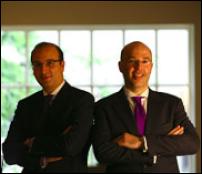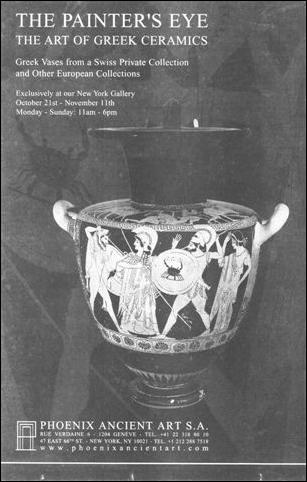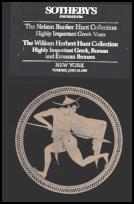Hicham Aboutaam: "It Is Good To Be Scrutinized"
Antiquities Dealer Hicham Aboutaam: "It Is Good To Be Scrutinized"
By Suzan Mazur

Hicham Aboutaam
With a searing ancient Near East focus, Hicham Aboutaam, the 30ish Lebanese antiquities dealer sweeps into the back of his Phoenix gallery showroom in Manhattan to greet me. He is dressed in French elegance, his handshake somewhat reserved. I later notice the smooth, manicured, almost translucent quality of his fingers -- certainly absent any trace of anything freshly dug up.
I've come unannounced to view Phoenix Ancient Art's controversial Greek & Roman exhibition of vases from the 6th century BC-4th century BC. The promo said most of them were acquired by a Swiss collector -- a Dr. C.J.D. -- "during the course of his archaeological studies in the 1960s and early 1970s".
Aboutaam tells me right off that C.J.D. are not the real initials of the previous owner. But the individual, still alive, insisted on anonymity in exhibtion and sale of the collection as a precondition to the sale to Hicham and his brother, Ali.
Beginning to sound like the Dorak Affair? (See… Scoop: Suzan Mazur: The Dorak Affair's Final Chapter)
Brother Ali runs the Geneva branch of Phoenix Ancient Art, where raids were carried out in March 2001 by Swiss and Italian authorities, and antiquities seized.

Hicham & Ali Aboutaam
The Italian government has issues with the brothers because of their business dealings with Giacomo Medici, who's appealing a 10-year sentence in Rome for antiquities trafficking.
The Aboutaams have also been under the scope because of Hicham's 2004 guilty plea to a misdemeanor federal charge of falsifying import documentation related to a silver drinking vessel from Iran that Phoenix sold for $950,000 (some experts say it's a fake). Ali Aboutaam was convicted that same year in Egypt and sentenced in absentia to 15 years for smuggling.
So there was a sense among critical observers that the plug might be pulled on the Aboutaam "Painter's Eye" vase show.
PRESS RELEASE: Phoenix Ancient Art to Premiere Important Collection of Greek Vases at Its New York City GalleryMasterpieces From Major Painters Among the Most Important Vases Remaining in Private Hands
NEW YORK, Oct. 5 /PRNewswire/ -- Phoenix Ancient Art, one of the world's leading dealers in rare, high quality antiquities from Western civilizations, today announced that its exhibition, "The Painter's Eye: The Art of Greek Ceramics. Greek Vases from a Swiss Private Collection and
Other European Private Collections," will be unveiled at its New York City gallery on October 20, 2006, opening to the public on October 21, and remaining on view until November 11, 2006.
A journalist in Rome emailed me to that effect following my story about the Cleveland Museum [Scoop: Italy Will Contest Medea Vase At Cleveland Museum ], which included some mention of the Aboutaams:
"I'm glad you noticed the Aboutaam exhibit coming up -- expect a firestorm. If they pull it off without problems it will be worth asking what exactly the Feds did for those two in exchange for their help in finding and returning that piece to Iraq a couple months ago..."
And it was rumored the brothers were not speaking to confrontational media, referring inquiries to handlers and attorneys instead. I was surprised that Hicham Aboutaam actually materialized to talk.
The other reason for my visit was curiosity about the DANGEROUS label that has been put on the brothers, the buzz that they were the new antiquities kingpins. That they'd replaced the old man of the trade, Medici's former partner, Bob Hecht.
Hecht is on trial in Rome charged with antiquities trafficking along with former Getty curator Marion True.
For adversarial media, there has been a sense that walking into Phoenix asking the wrong questions might be tantamount to stepping foot in 1994 Algiers.
"Is Bob Hecht still alive?", Hicham Aboutaam looking exactly into my eyes responds to my inquiry about whether Hecht attended the opening of Phoenix's Greek & Roman vase exhibit.
It is certainly true Hecht's also been out of action because of the frailties of old age -- though he's not been out of sight at Hoad's tennis club near Marbella, so why should he miss an important exhibition of vases from the period he has the greatest "affection" for?
Author Peter Watson reports in The Medici Conspiracy that Geneva dealer Frida Tchacos told Italy's Medici prosecutor, Paolo Ferri, who was part of the raid on Phoenix-Geneva, that the Aboutaams were indeed "replacing the older dealers [Hecht, et al]".
"And in the last . . . in the last years I learnt that he [Giacomo Medici] was in partnership or worked with the Aboutaams, the Arabs of Freeport, Geneva . . . at a certain point at Sotheby's the Aboutaams were seen buying [very important] vases next to Medici."
Watson also cites Tchacos telling Ferri that in recent years Shelby White was buying a lot from the Aboutaams (and previously from Robin Symes via Hecht via Medici).
Diamond and political influence peddler, Maurice Tempelsman, has also been spotted shopping at Phoenix-NY in recent months. [See… Mazur: Deeper Into The Dillon-Euphronios Nexus]
Fourteen catalogs were among the items seized by Swiss and Italian authorities at Phoenix-Geneva in 2001. The catalogs included pieces bought and sold by the Aboutaams between June 1995 and October 2000 at Sotheby's, Christie's and Bonhams. Says Watson:
"In at least two of these cases, the objects had started out with Medici, as proved by the Polaroids. They had then been "sold" at auction, both by the Aboutaams, and ended up back with Medici. That confirms laundering in seven sales, and possibly as many as twenty-one, stretching from 1987 until 2000."
But, however amazing it may seem, the recent Greek & Roman Aboutaam vase exhibition, opened and closed uneventfully in New York. With virtually no press coverage, 20 of the 25 vases and one fish plate had been sold prior to my visit -- according to Aboutaam.
Considering Bob Hecht's professional "retirement", could then some of the ratting on the Aboutaams also reflect a turf war among the dealers for pre-eminence?
Michel van Rijn's web site may hold clues. The art dealer turned master of "the page everyone reads though may not admit it", has posted a volume of material about the Aboutaams [http://www.michelvanrijn.nl/artnews/artnws.htm] and is now in court defending himself. Van Rijn's even got a phone conversation up about a contract being taken out on his life by the Aboutaams.
These kind of threats to journalists are, indeed, a reality in the dirty business of antiquities dealing. As I've noted before, Hecht attempted to assault me. And Hecht's pal, Turkish dealer Fuat Uzulmez, advised me on the way out of Hecht's 1990 Hesperia Arts auction that the Turkish dealers were looking to get even with my friend, journalist Ozgen Acar, for Acar's expose in Connoisseur magazine (10/90) on the Munich-based Turkish antiquities mafia.
Uzulmez, putting his arm around me, whispered in my ear, "We are going to kill him." Acar has his own stories to tell about intimidation from the antiquities crowd.
However, van Rijn has reported that New York dealer/appraiser Dr. Jerry Eisenberg with a Ph.D., 1983, Art History, Pacific Western U, a distance learning school in California -- is also in litigation with the Aboutaams.
"Have you noticed that Eisenberg, who is van Rijn's friend, and certain other dealers never get targeted on van Rijn's site?" Aboutaam asked.
Met Ancient Near East expert Oscar Muscarella, one of the heroes of Peter Watson's Medici Conspiracy, says this about Eisenberg:
"In the magazine Connoisseur, May 1987, pages 99-109, Thomas Hoving and Geraldine Norman wrote an article about the scandal at the Getty involving its curator Jiri Frel. He was exposed by the Getty authorities as having falsified both the monetary value and scholarly claims about the alleged ancient age of a large number of classical antiquities that he had either purchased or accepted as donations for the museum. In fact, and reluctantly acknowledged by the Getty authorities, not only were many of these purchased and donated objects overvalued far above market value, but a good number of them were, in fact, modern forgeries. On page 105, Hoving and Norman report that Eisenberg was one of the dealers who appraised many of the antiquities involved; and on page 107, they reveal the Eisenberg-Frel partnership in these fraudulent transactions."
Back to Aboutaam, who says none of what van Rijn claims actually happened and that he and his brother are demanding van Rijn take down all damaging references to them, make a public apology and pay 100,000 pounds.
Peter Watson, however, has not been asked to remove his references to the Aboutaams in Medici Conspiracy, which has become the definitive book on the trade in looted art, particularly Italian looted art.
Aboutaam insisted he and his brother Ali are playing by the new rules. "It is good to be scrutinized," he said.
Moreover, Aboutaam made the point that virtually all the ancient art in circulation is looted from somewhere. He said Phoenix will continue to pursue the many important objects in collections since the 40s and 50s. He was passionate in saying "There is a lot of money to be made."
But it does appear some of the old rules are still in play, especially the ones established for viewing the recent Phoenix Greek & Roman vase exhibition. The media was prevented from attending the opening because collectors and other clients would be there doing their thing. Which is exactly the reason the media wanted to be there.
Here's an email on the subject:
"Dear Ms. Mazur,Thank you very much for your interest in our upcoming exhibition on Greek vases. I apologize for the delay in getting back to you, but we were in the midst of setting up a special Press Preview [emphasis added] on Thursday, October 19th and I wanted to ensure I had all the details for you before I responded.
I would ask you to please contact our press representatives . . . to arrange a time to visit the gallery on the 19th. . . . Alternatively, I can have one of them call you directly if you'd like to provide your phone number.
Thank you again for your interest, and we look forward to meeting you.
Best regards,
Bibiane Choi
Electrum, Exclusive Agent for Phoenix Ancient Art "
A separate by-appointment pre-exhibition tour for media was arranged by Aboutaam's public relations people per the above email. I skipped it, but was reminded by pr that even if I visited the public viewing, I should identify myself, so as not to interfere with sales to clients.
"Dear Susan:Sorry that you can't make it on Thursday.
Please be in touch with us before you'd like to visit the Gallery so that Phoenix can make sure that there is someone there to host you. Additionally, Phoenix needs to respect the privacy of its clients and prospective clients, so they need to be sure, in advance, that no one else has made an appointment to come by when you (or other media) might be there.
Best,
Richard Dukas "
"Have you had some media reviews of the Greek & Roman vases exhibit?" I asked Aboutaam.
"Not yet," he said, "but we expect one in Forbes and Art & Antiques."
"And the New York Times?"
"The New York Times is only covering 'illegal' antiquities," Aboutaam said he was told by the paper. [See… Scoop: Add NYT To Bob Hecht Antiquities Ring Organigram?] However, the Times did run a $20,601 quarter-page ad for the Aboutaam October 21 - November 11 show, in the Friday, October 20, 2006 issue.

New York Times advert for Pheonix's Painter's Eye show
The vases in the Painter's Eye show, set on pedestals, appeared to be floating when viewed from East 66th Street through the gallery's eye-level windows. They were exhibited without showcases, facilitating optimum study of the paint, the cracks, missing phalluses, inscriptions, etc.
Before I'd arrived, the most important vase had already been sold for $1.5 million, according to Aboutaam, although it was still on display. It was a red-figure wine cup, 490BC-480 BC, attributed to the painter Makron and signed by the potter, Hieron. The vase depicts the departure into battle of the Achaean warrior Antilochos, who stands before his father, Nestor, king of Pylos.
The two do not make eye contact. Nestor has had a premonition of his son's death in battle and knows "their separation will be for eternity".
Kind of the feeling you get after viewing the entire vase collection at Phoenix.
The show's promo indicates some objects also came from other European collections, including that of Lucien Bonaparte, the amateur archaeologist brother of Emperor Napoleon I.
One piece, a red-figure kylix, 500 B.C., attributed to the painter Epidromos and inscribed "Epidromos is beautiful", was clearly not one excavated in Italy by L. Bonaparte or tucked away for almost 50 years in Dr. C.J.D.'s Swiss collection, either. In fact, the wine cup was the auction catalogue cover art for the Hunt-Sotheby's sale in 1990. It went for $150,000 plus tax at the time.
The only provenance given in the Aboutaams' catalogue for the piece is "Formerly in the collection of Nelson Bunker Hunt".


Click for big versions
Hunt-Sotheby's catalog cover of wine cup & Aboutaam catalog wine cup image
The cup depicts a young hunter, holding a spear, naked except for a wide-brimmed hat tied under his chin and short mantle draped across his shoulders; the exterior scenes of the cup are of naked revelry. It had been sold to Bunker Hunt by Bruce McNall via Bob Hecht via Giacomo Medici.
So why has the NYT, which reported the Hunt-Sotheby's auction (Rita Reif 6/20/90) not followed up if the Times is indeed also playing by the new rules and covering looted antiquities these days? It couldn't have anything to do with the $20,601 ad, could it?
In any event, as of Monday, November 6, the Aboutaam vase advertised in the Times, and described in the promo as formerly belonging to Dr. C.J.D., had not been sold. It is a red-figure hydria, 500 B.C, attributed to the painter Dikaios with the same battle theme of Herakles and Kyknos, as the signed fragmentary Euphronios vase from the Hunt-Sothbey's auction.
The fragmentary Euphronios is now owned by New York collector Shelby White and is on loan to the Met. It was purchased for White's late husband, Leon Levy, by dealer Robin Symes who paid $1.76 million for it at the time. It rests on a pedestal just down the hall from the Sarpendon Euphronios krater, whose title of ownership was transferred from the Met to Italy earlier this year.
And the Italians are as interested in the Herakles-Kyknos Euphronios as they were in the Sarpendon Euphronios.
But surely Dr. C.J.D.'s Swiss provenance is proof enough that the Aboutaams' Herakles-Kyknos carries no risk for the buyer? Perhaps it'll turn up in Shelby White's hoard as insurance against loss of her Kyknos Euphronios.
 Suzan
Mazur's stories on art and antiquities have been published
in The Economist, Financial Times, Connoisseur, Archaeology
(cover) and Newsday. Some of her other reports have
appeared on PBS, CBC and MBC. She has been a guest on
McLaughlin, Charlie Rose and various Fox Television News
programs. Email:
sznmzr@aol.com
Suzan
Mazur's stories on art and antiquities have been published
in The Economist, Financial Times, Connoisseur, Archaeology
(cover) and Newsday. Some of her other reports have
appeared on PBS, CBC and MBC. She has been a guest on
McLaughlin, Charlie Rose and various Fox Television News
programs. Email:
sznmzr@aol.com


 Peter Dunne: Dunne's Weekly - Trump's Tariffs Still Pose Risks For New Zealand
Peter Dunne: Dunne's Weekly - Trump's Tariffs Still Pose Risks For New Zealand Keith Rankin: Barbecued Hamburgers And Churchill's Bestie
Keith Rankin: Barbecued Hamburgers And Churchill's Bestie Gordon Campbell: On Why The US Stands To Lose The Tariff Wars
Gordon Campbell: On Why The US Stands To Lose The Tariff Wars Eugene Doyle: Before It’s Too Late - Reimagine New Zealand’s Military Future
Eugene Doyle: Before It’s Too Late - Reimagine New Zealand’s Military Future  Binoy Kampmark: Gender Stunts In Space - Blue Origin’s Female Celebrity Envoys
Binoy Kampmark: Gender Stunts In Space - Blue Origin’s Female Celebrity Envoys Richard S. Ehrlich: A Deadly Earthquake & Chinese Construction
Richard S. Ehrlich: A Deadly Earthquake & Chinese Construction